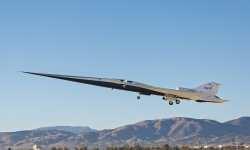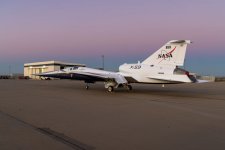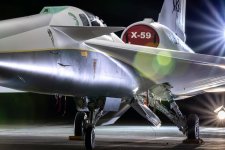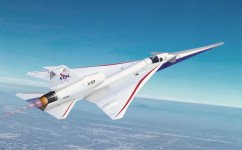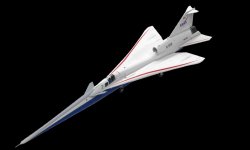X-59 Quiet Supersonic Technology (QueSST)
Low-Boom Flight Demonstration (LBFD)
On 28 October 2025, Lockheed Martin Skunk Works® (NYSE: LMT), in partnership with NASA, successfully completed the first flight of the X-59, a revolutionary, quiet supersonic aircraft designed to pave the way for faster commercial air travel. The X-59 took off from Skunk Works' facility at U.S. Air Force Plant 42 in Palmdale, California, before landing near NASA's Armstrong Flight Research Center in Edwards, California. The X-59 performed exactly as planned, verifying initial flying qualities and air data performance on the way to a safe landing at its new home.
"We are thrilled to achieve the first flight of the X-59," said OJ Sanchez, vice president and general manager of Lockheed Martin Skunk Works. "This aircraft is a testament to the innovation and expertise of our joint team, and we are proud to be at the forefront of quiet supersonic technology development."
After nearly a decade of development and multiple postponements, NASA's X-59 Quesst experimental supersonic aircraft finally completed its maiden flight on October 28, 2025. The one-hour inaugural sortie departed from Lockheed Martin's Skunk Works facility at Air Force Plant 42 in Palmdale, California at 8:14 a.m. Pacific time, with NASA test pilot Nils Larson at the controls. The aircraft climbed to 12,000 feet and conducted basic handling checks at speeds between 170 and 250 knots before landing at nearby Edwards Air Force Base at 9:21 a.m.
The X-59 program experienced a lengthy series of delays stretching back to its initial conception. When preliminary design work began in February 2016, NASA and Lockheed Martin originally aimed to have the aircraft flying by 2020 or 2021. That target proved overly optimistic, and the first flight date progressively slipped to 2023, then to 2024, and finally to 2025. Throughout this year, NASA maintained its commitment to achieving first flight before year's end, even as the months ticked away and skepticism grew about whether the team could meet the deadline.
The root causes of these persistent delays centered on technical challenges discovered during the exhaustive ground testing campaign. After the aircraft was formally unveiled in January 2024, engineers put it through a comprehensive series of evaluations that revealed nagging problems with multiple critical systems. The flight control computer exhibited issues that required resolution, the hydraulic system needed troubleshooting, and various other components failed to perform as expected. These weren't minor glitches that could be ignored or deferred—they were fundamental problems that had to be addressed before the aircraft could safely take to the skies.
The X-59 is a one-of-a-kind supersonic aircraft designed to demonstrate the ability to fly at supersonic speeds while reducing the sonic boom to a gentle thump. In doing so, the X-59 aims to overcome one of the primary barriers to supersonic commercial flight, which is currently restricted over land due to noise concerns. The X-59's successful development and flight testing will inform the establishment of new data-driven acceptable noise thresholds related to supersonic commercial flight over land, paving the way for a new generation of supersonic aircraft that can efficiently and sustainably transport passengers and cargo twice as fast as aircraft today.
"X-59 is a symbol of American ingenuity. The American spirit knows no bounds. It's part of our DNA – the desire to go farther, faster, and even quieter than anyone has ever gone before. This work sustains America's place as the leader in aviation and has the potential to change the way the public flies," said Sean Duffy, acting NASA Administrator.
Skunk Works will continue to lead the aircraft's initial flight test campaign, working closely with NASA to vexpand the X-59's flight envelope over the coming months. Part of this test journey will include the X-59's first supersonic flights, where the aircraft will achieve the optimal speed and altitude for a quiet boom. This will enable NASA to operate the X-59 to measure its sound signature and conduct community acceptance testing. This achievement demonstrates Lockheed Martin's commitment to pushing the boundaries of aerospace innovation and its dedication to creating cutting-edge solutions for the future of flight.
NASA’s new experimental aircraft, designed with quiet supersonic technology and intended to help open a new era in faster-than-sound air travel over land, will forever be known in the history books as the X-59 QueSST. The X-59 is shaped to reduce the loudness of a sonic boom reaching the ground to that of a gentle thump, if it is heard at all. It will be flown above select U.S. communities to generate data from sensors and people on the ground in order to gauge public perception. That data will help regulators establish new rules to enable commercial supersonic air travel over land. The U.S. Air Force, which is the government entity responsible for assigning X-number designations and the popular name associated with the aircraft, officially informed NASA of their decision on 26 June 2018. “For everyone working on this important project, this is great news and we’re thrilled with the designation,” said Jaiwon Shin, NASA’s associate administrator for aeronautics.
Since the introduction of the legendary X-1 in 1946, scientists have used the X-plane designations to identify experimental aircraft and rockets used to explore new aerospace technologies. As of early 2016, the X-57 designator appeared to remain un-assigned. The assignment of this designator to this aircraft is conjectural.
In 2016 NASA announced a 10-year plan by NASA Aeronautics to achieve ambitious goals in reducing fuel use, emissions, and noise by the way aircraft are designed, and the way they operate in the air and on the ground. One exciting piece of this 10-year plan is New Aviation Horizons – an ambitious undertaking by NASA to design, build and fly a variety of flight demonstration vehicles, or “X-planes.” The New Aviation Horizons X-planes would typically be about half-scale of a production aircraft, although some may be smaller or larger, and are likely to be piloted. Design-and-build would take several years, with vehicles going to flight starting around 2020 depending on funding.
One X-plane would be a business-jet-sized supersonic vehicle that burns low carbon bio-fuels and generates such quiet sonic booms that people on the ground would barely hear them.
The return of supersonic passenger air travel is one step closer to reality with NASA's award of a contract for the preliminary design of a “low boom” flight demonstration aircraft. This is the first in a series of ‘X-planes’ in NASA's New Aviation Horizons initiative, introduced in the agency’s Fiscal Year 2017 budget. NASA Administrator Charles Bolden announced the award at an event 29 February 2016 [Leap Day] at Ronald Reagan Washington National Airport in Arlington, Virginia.
“NASA is working hard to make flight greener, safer and quieter – all while developing aircraft that travel faster, and building an aviation system that operates more efficiently,” said Bolden. “To that end, it’s worth noting that it's been almost 70 years since Chuck Yeager broke the sound barrier in the Bell X-1 as part of our predecessor agency's high speed research. Now we’re continuing that supersonic X-plane legacy with this preliminary design award for a quieter supersonic jet with an aim toward passenger flight."
NASA selected a team led by Lockheed Martin Aeronautics Company of Palmdale, California, to complete a preliminary design for Quiet Supersonic Technology (QueSST). The work would be conducted under a task order against the Basic and Applied Aerospace Research and Technology (BAART) contract at NASA's Langley Research Center in Hampton, Virginia.
After conducting feasibility studies and working to better understand acceptable sound levels across the country, NASA's Commercial Supersonic Technology Project asked industry teams to submit design concepts for a piloted test aircraft that can fly at supersonic speeds, creating a supersonic "heartbeat" -- a soft thump rather than the disruptive boom currently associated with supersonic flight.
“Developing, building and flight testing a quiet supersonic X-plane is the next logical step in our path to enabling the industry's decision to open supersonic travel for the flying public," said Jaiwon Shin, associate administrator for NASA’s Aeronautics Research Mission.
Lockheed Martin received about $20 million over 17 months for QueSST preliminary design work. The Lockheed Martin team included subcontractors GE Aviation of Cincinnati and Tri Models Inc. of Huntington Beach, California.
The company developed baseline aircraft requirements and a preliminary aircraft design, with specifications, and provided supporting documentation for concept formulation and planning. This documentation would be used to prepare for the detailed design, building and testing of the QueSST jet. Performance of this preliminary design also must undergo analytical and wind tunnel validation.
In addition to design and building, this Low Boom Flight Demonstration (LBFD) phase of the project also included validation of community response to the new, quieter supersonic design. The detailed design and building of the QueSST aircraft, conducted under the NASA Aeronautics Research Mission Directorate's Integrated Aviation Systems Program, would fall under a future contract competition.
A task order was awarded for preliminary design of a Quiet SuperSonic Technology (QueSST) aircraft concept. An Aircraft System Requirements Review (ASRR) was completed in June 2016 to refine and finalize NASA's mission and aircraft requirements. Maturation and integration of a preliminary QueSST aircraft concept confirmed that the desired mission and aircraft requirements are valid. A Preliminary Design Review (PDR) of this aircraft concept would be completed in June 2017. The resulting requirements and design approaches may be leveraged for the detailed design phase.
NASA Armstrong Flight Research Center planned to issue a Request for Proposal (RFP) for Low-Boom Flight Demonstration (LBFD) in mid-2017. NASA's Aeronautics Research Mission Directorate (ARMD) strategy is guided by six strategic thrusts identified in response to three overarching global mega-drivers that will, in large part, shape the needs of aeronautical research in the coming years. These drivers and thrusts are described in the ARMD Strategic Implementation Plan (SIP). In the near term (2015-2025), Strategic Thrust 2, Innovation in Commercial Supersonic Aircraft, outlines the ARMD objective of enabling the establishment of a standard for acceptable overland supersonic flight, in cooperation with international standards organizations. ARMD would develop and validate analysis tools and technologies intended to enable the design and development of supersonic aircraft with low sonic boom. In the longer term (2025-2035), ARMD would continue research on technologies required to meet the desired boom level in larger aircraft, but would also conduct research in areas related to other challenges to successful supersonic transports.
Under NASA ARMD's Advanced Air Vehicles Program (AAVP), the Commercial Supersonic Technology (CST) Project provides the research and leadership to achieve ARMD's objectives in Strategic Thrust 2. ARMD has formed Research Themes that support the desired outcomes for this strategic thrust (see the ARMD SIP link above). Within these Research Themes, the CST Project focused a majority of its research on certain key Technical Challenges that were viewed as enabling to the Strategic Thrust 2 near-term outcomes. The current Technical Challenges were: 1) Integrated Low Boom Aircraft Design, 2) Sonic Boom Community Response Metric and Methodologies, and 3) Low-Noise Propulsion for Low-Boom Aircraft. Concurrently, the CST Project also conducts research in other key areas related to successful supersonic transports, such as improvements in supersonic cruise efficiency, reduced emissions, aero-servo-elasticity, and flight systems.
Based on research over the past few years, NASA determined that the best approach to accomplish the goals of the Thrust 2 near-term objective and the first two CST Project Technical Challenges was to conduct a flight demonstration. To that end, the CST Project conducted concept feasibility studies and project planning for a Low-Boom Flight Demonstration (LBFD) aircraft that would provide validation of design tools and technologies applicable to low sonic boom aircraft and create a database of community response supporting the development of a noise-based standard for supersonic overland flight.
NASA refined a set of LBFD aircraft capabilities required to conduct effective community response studies. NASA's objectives would be accomplished through the design, construction, and flight validation of a sub-scale research aircraft that creates a shaped sonic boom signature with a calculated loudness level of 75 PLdB [Perceived Level (PL), decibels (dB)] or less during supersonic cruise (Mach = 1.4) flight. Although the aircraft would be smaller in size than future supersonic airliners, its sonic boom ground signature would be traceable to that of the larger aircraft. The LBFD aircraft would be capable of performing multiple supersonic overflights of a single community with passes that are nominally 50 miles in length, and 20 minutes apart on a single flight.
Under NASA ARMD's Integrated Aviation Systems Program (IASP), the LBFD Project would be executed in two distinct phases, with a third phase envisioned as a follow-on activity. Phase 1 includes the LBFD aircraft development activities from detailed design through fabrication, concluding with functional checkouts and supersonic envelope expansion.
In Phase 2, a NASA-led team would perform low-boom acoustic validation flights of the LBFD aircraft. These flights would be conducted from NASA's Armstrong Flight Research Center (AFRC) and characterize and evaluate the near-field, mid-field, far-field, and ground signatures from the LBFD aircraft. This characterization would include the effects of changing atmospheric and aircraft flight conditions.
Phase 2 would conclude with an initial community response overflight study involving communities near AFRC. The purposes of this study would be validation of the community test designs developed by the CST Project and an initial exploration of community acceptance of low-boom noise.For the Phase 3 follow-on, a NASA-led team would conduct low-boom community response overflight studies with multiple test campaigns using the LBFD aircraft over varied locations. Studies may include multiple deployments over a 2-year period to capture a representative spectrum of communities, geography, and meteorological conditions across the United States. The primary data from these studies would be community response, with limited collection of aircraft, ground, and meteorological data.
The ultimate goal of Phase 3 would be to develop a low-boom community response database that would be provided to the Federal Aviation Administration (FAA) and International Civil Aviation Organization (ICAO) Committee on Aviation Environmental Protection (CAEP) in support of their development of a noise-based standard for supersonic overland flight.
NASA planned to select a Vehicle Contractor for the Phase 1 detailed design, build, test, and then delivery of the LBFD aircraft system that would be flown in Phases 2 and 3. NASA would retain oversight of the airworthiness certification and anticipates being a significant participant in Phase 1 activities. NASA would provide support that would include in-flight and ground systems, instrumentation and operations, simulation, wind-tunnel testing, and safety and mission assurance. NASA would also supply aircraft components and systems as Government Furnished Equipment (GFE) whenever feasible, and considered to add value to the development of the LBFD aircraft. NASA envisions significant opportunities for collaboration with industry and academia, both domestic and international, during Phase 2 and 3 activities.
NASA anticipated issuing a performance-based Request for Proposal for the design, build, and test of the LBFD aircraft, as described in Phase 1, with potential for a second aircraft. The procurement would be a requirements-driven approach, as opposed to build to print, and the maturity of the proposed concept was expected to be consistent with a PDR level of development. The Government does not intend to acquire a commercial item using FAR Part 12. This would be an unrestricted procurement (full and open competition). The North American Industry Classification System (NAICS) code for this procurement was 336411 - Aircraft Manufacturing, with a small business size standard of 1,500 employees.
In accordance with Federal Acquisition Regulation (FAR) 9.104-1, FAR 9.104-2, and FAR 9.105(b)(1), NASA intended to conduct a pre-RFP release Responsibility Determination. NASA may use the list of responsible vendors to facilitate a pre-solicitation release of more detailed requirements, design data, and specifications that have resulted from the preliminary design activity.
NASA’s first large scale, piloted X-plane in more than three decades is cleared for final assembly and integration of its systems following a major project review by senior managers held 16 December 2019 at NASA Headquarters in Washington. The management review, known as Key Decision Point-D (KDP-D), was the last programmatic hurdle for the X-59 Quiet SuperSonic Technology (QueSST) aircraft to clear before officials meet again in late 2020 to approve the airplane’s first flight in 2021. “With the completion of KDP-D we’ve shown the project is on schedule, it’s well planned and on track. We have everything in place to continue this historic research mission for the nation’s air-traveling public,” said Bob Pearce, NASA’s associate administrator for Aeronautics.
NASA publicly acknowledged that several technical challenges were identified over the course of 2023, and the Quesst team had to methodically work through each one. This painstaking process consumed far more time than initially anticipated. The agency couldn't simply rush the aircraft into flight with unresolved systems issues, particularly given the experimental nature of the platform and the unique challenges posed by its unconventional design. Every subsystem had to be validated, every flight control response verified, and every potential failure mode analyzed before first flight could be authorized.
The ground test campaign itself became increasingly elaborate as engineers sought to gain maximum confidence before committing to flight. Low-speed taxi tests began in July 2025, with the aircraft initially moving at just a few miles per hour to validate basic steering and braking functions. The team then progressed through medium-speed tests before advancing to high-speed taxi runs that simulated the conditions the aircraft would experience during takeoff. Each phase generated massive amounts of data—NASA equipped the X-59 with 60 different data streams capturing over 20,000 parameters onboard. This wealth of information allowed engineers to scrutinize every aspect of the aircraft's performance and identify potential issues before they became airborne problems.
The consequences of these delays extend well beyond the aircraft's first flight. NASA had originally planned to provide crucial overflight noise data to the International Civil Aviation Organization in time for the 2028 meeting of its Committee on Aviation Environmental Protection, which was expected to establish new sonic boom standards. That ambitious timeline is no longer achievable. The delays to the start of flight testing have pushed the target back to the CAEP/15 meeting scheduled for 2030, representing a two-year slip in the program's ability to influence international aviation regulations.
This regulatory timeline matters immensely because the entire purpose of the X-59 is to demonstrate that supersonic flight over land can be achieved without the disruptive sonic boom that has kept such operations banned for decades. The aircraft incorporates numerous design features specifically intended to prevent the typical loud boom, instead generating what NASA describes as a quiet thump. The extended nose section measuring 38 feet in length, the carefully shaped fuselage that prevents shockwaves from merging, and the top-mounted General Electric F414 engine fed by a diverterless bump inlet all work together to direct and dissipate shockwaves in ways that minimize ground-level noise.
The mission profile calls for the X-59 to eventually cruise at Mach 1.42 at altitudes up to 55,000 feet, producing an effective perceived noise level of just 75 decibels—roughly equivalent to a car door closing as heard from inside a house. But reaching that point will require a phased approach. The first flight was deliberately conservative, staying subsonic and focusing entirely on verifying system integration, handling qualities, avionics functionality, and structural behavior under real aerodynamic loads. Only after the team completes envelope expansion testing will they push the aircraft into transonic and supersonic speeds.
The three-phase test program begins with this initial envelope expansion work, which will incrementally increase speed and altitude while validating all aircraft systems. Phase two, likely to commence in 2026, will focus on acoustic validation—actually measuring the sonic signature the aircraft produces to confirm it matches predictions from computational models and wind tunnel testing. Phase three represents the ultimate goal: flying the X-59 over multiple U.S. cities to gauge community response to the aircraft's noise signature. NASA will partner with local governments to deploy microphones, conduct surveys, and gather environmental data that quantifies how people actually perceive and react to the reduced sonic boom.
The delays have tested the patience of everyone involved in the program, from NASA administrators to Lockheed Martin engineers to the broader aerospace community watching anxiously from the sidelines. Throughout 2025, NASA repeatedly affirmed its commitment to achieving first flight before year's end, even as observers noted the calendar advancing and the remaining window shrinking. The agency's persistence in mapping every step of the planned first flight, rehearsing procedures, analyzing data from taxi tests, and ensuring all systems were genuinely ready reflected a determination not to rush into flight prematurely regardless of schedule pressure.
Despite the long wait and numerous postponements, the successful completion of the maiden flight on 28 October 2025 vindicated the methodical approach. The aircraft performed exactly as planned, with all systems functioning normally and the handling characteristics matching expectations. Larson reported positive initial impressions of the aircraft's flying qualities, and the safe landing at Edwards marked the beginning of what promises to be a transformative test program. The X-59 will now be based at NASA's Armstrong Flight Research Center at Edwards, where it will undergo the systematic expansion of its flight envelope over the coming months.
The broader implications of the X-59 program extend far beyond this single experimental aircraft. If the testing campaign successfully demonstrates that supersonic flight can be achieved with acceptable noise levels, it could fundamentally reshape both regulations and the commercial aviation landscape. Current rules prohibit supersonic flight over land in the United States and most other countries, effectively confining such operations to oceanic routes. These restrictions were a major factor in Concorde's commercial struggles and eventual retirement, and they represent the primary barrier preventing the development of new supersonic passenger aircraft.
The X-59's data could provide the technical foundation for regulators to replace blanket prohibitions with noise-based certification standards. Rather than categorically banning supersonic flight over populated areas, authorities could instead establish acceptable noise thresholds that aircraft must meet. This would open the door for commercial supersonic designs that incorporate the quiet boom technologies being validated on the X-59. Multiple companies are already developing supersonic business jets and airliners in anticipation of regulatory changes, and the success or failure of the Quesst mission will largely determine whether these ambitious projects can proceed.
The program also carries geopolitical significance, as other nations watch NASA's progress with keen interest. China, Russia, and several other countries are pursuing their own supersonic transport programs, and the question of how international regulations will evolve remains open. NASA has emphasized that the Quesst program's acoustic data will be released publicly to ensure global regulators can evaluate findings transparently. This open approach aims to build international consensus around new standards rather than creating a fragmented regulatory environment where different countries impose different rules.
Looking ahead, the X-59 faces a demanding test schedule that will progressively expand its operational envelope. After validating subsonic handling characteristics, the team will carefully approach the transonic regime where shockwave formation begins. Successfully navigating through the transonic zone and into smooth supersonic flight represents a critical milestone. Only then can the acoustic validation phase begin, with instrumented chase aircraft and ground-based sensors measuring the actual sonic signature the X-59 produces. These measurements will be compared against predictions to validate the computational models that guided the aircraft's design.
The community response testing phase scheduled to begin in 2026 or beyond will mark the program's most visible phase. The X-59 will conduct repeated supersonic passes over selected cities while NASA collects data on public perception and reaction. These overflights will be carefully coordinated with local authorities and residents will be surveyed about their experience. The goal is to gather statistically significant data demonstrating that the quiet boom technology successfully reduces noise to levels the public finds acceptable for routine operations. This human response data will be just as important as the acoustic measurements in convincing regulators to revise existing rules.
The technical challenges that delayed the program underscore the difficulty of developing experimental aircraft that push boundaries in multiple dimensions simultaneously. The X-59 isn't just fast—it also incorporates unconventional design features like the cockpit with no forward visibility, requiring pilots to rely entirely on an enhanced flight vision system using cameras and displays. The top-mounted engine configuration required extensive inlet design work to ensure proper airflow across the speed range. The flight control system had to be carefully tuned to provide good handling qualities despite the aircraft's unusual aerodynamic characteristics. Solving these interconnected challenges inevitably took longer than optimistic initial schedules suggested.
Yet despite all the delays and frustrations, the October 28 first flight represents a genuine achievement and a pivotal moment for supersonic aviation. The X-59 is now flying, the test program is underway, and the data that will inform the future of overland supersonic flight is finally being collected. Whether the program ultimately succeeds in its goal of changing regulations and enabling a new generation of quiet supersonic transports remains to be seen, but the long-delayed first flight marks the essential first step on that journey. The years of development and months of ground testing have culminated in an aircraft that works, flies safely, and is ready to demonstrate whether supersonic aviation can finally return to the skies over land.

|
NEWSLETTER
|
| Join the GlobalSecurity.org mailing list |
|
|
|



